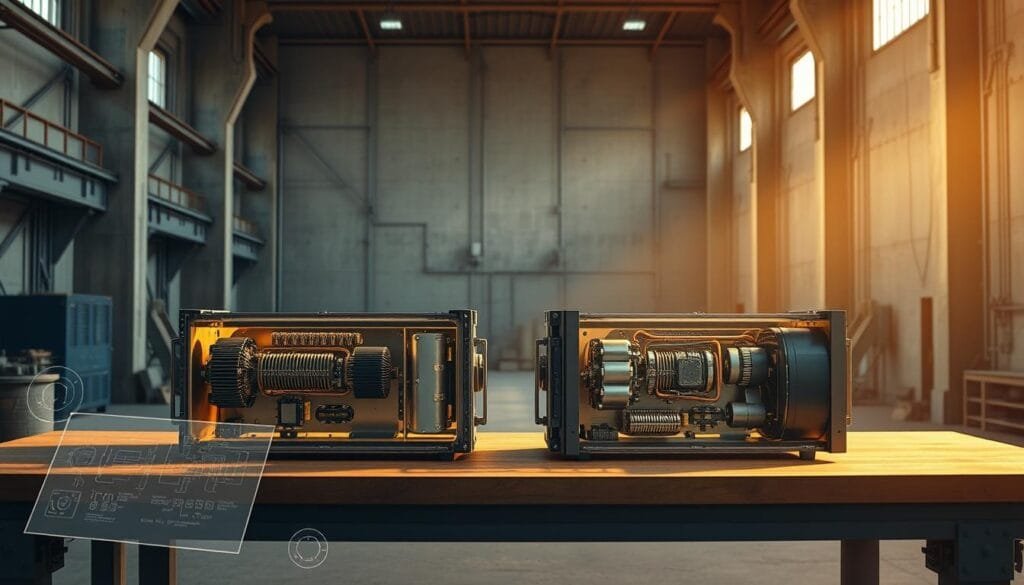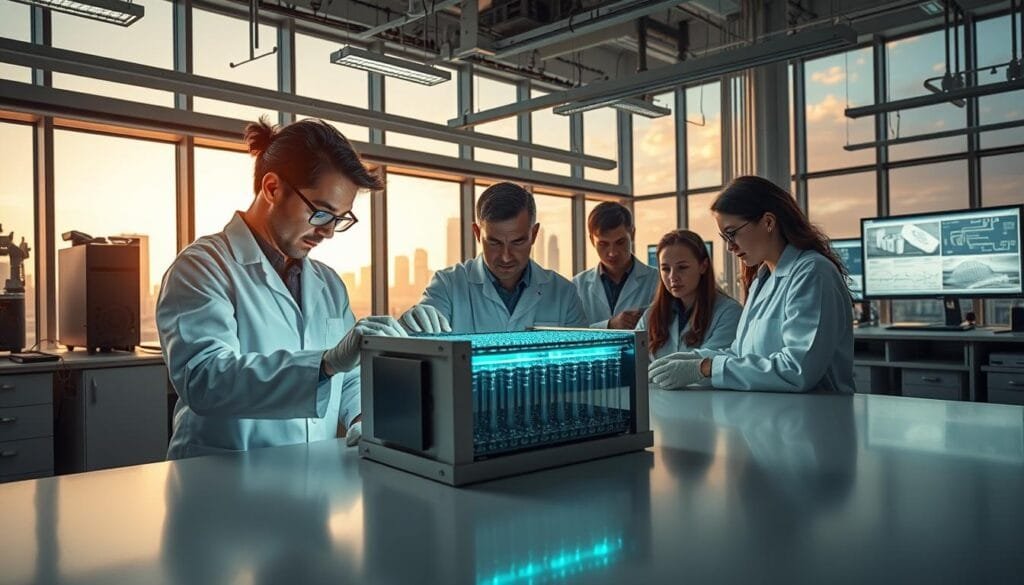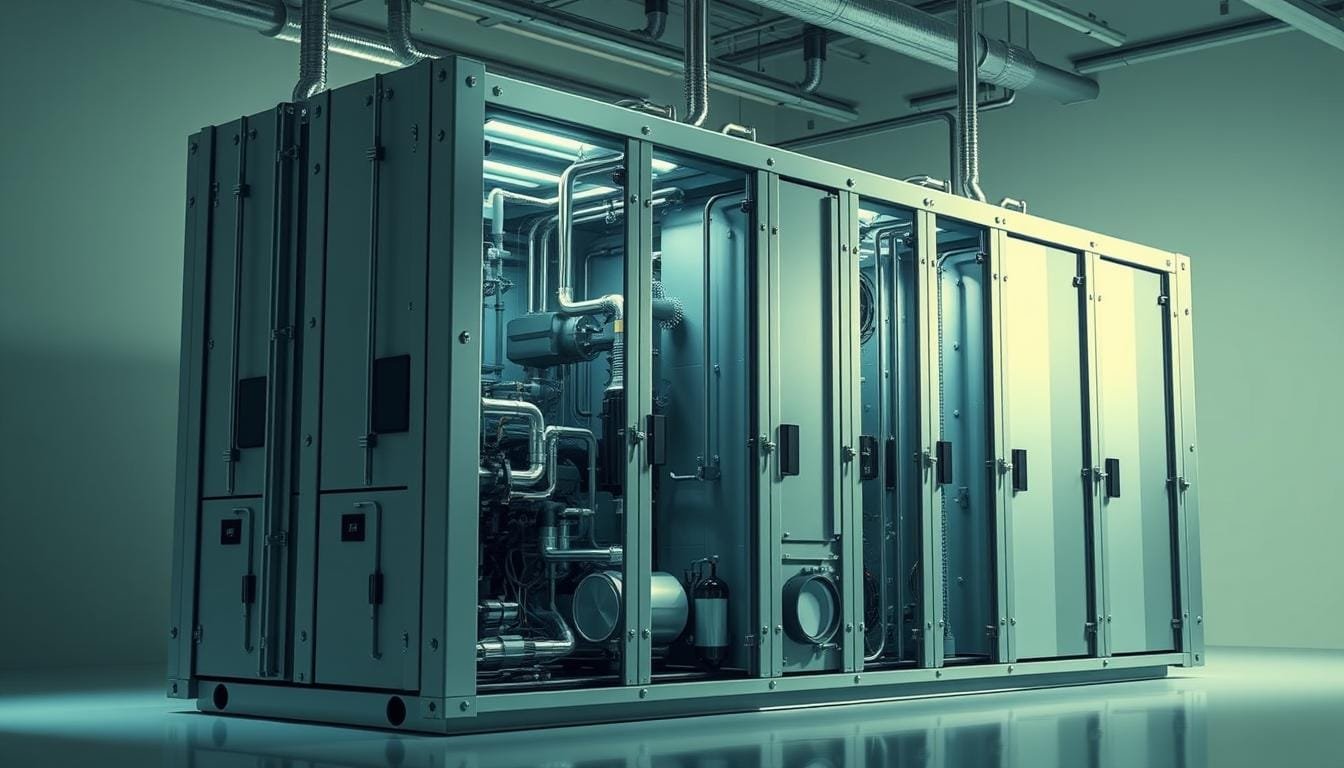Imagine a battery that can hold energy for 100 hours at a fraction of today’s cost. Form Energy’s iron air battery is a game-changer in metal-air energy storage. It could change how we handle electrical grids in the U.S.
The iron air battery is set to change the game in energy storage. It uses iron, a cheap and common element, to create a green, long-lasting energy solution. A $405 million investment by Form Energy shows how big its impact could be.
We’re on the verge of a big change in energy storage. Being able to keep renewable energy for longer could change how we manage our grids. It could make sustainable power more reliable and easy to get than ever.
Key Takeaways
- Iron air batteries can store energy for up to 100 hours
- Cost of storage is projected to be less than one-tenth of lithium-ion technology
- Form Energy plans to expand manufacturing to over 1 million square feet by 2028
- The technology supports long-duration grid energy storage
- Potential to unlock tens of gigawatts of multi-day storage demand
What is an Iron Air Battery?
Rechargeable metal-air batteries are a new way to store energy. Iron-air batteries are leading the way in sustainable power. They use iron and oxygen to store energy in a green way.
An iron-air battery works by changing energy through a special chemical process. It uses iron’s natural properties. It stores and releases electricity by using oxygen from the air.
Defining the Core Mechanism
The battery’s main process is a series of chemical reactions. These reactions allow it to store and give back energy. When it discharges, iron turns into something else, making electricity. When it’s recharged, it goes back to its original state.
Key Components of the Technology
- Iron Electrode: The main part that stores energy
- Air Electrode: Helps with oxygen interaction
- Water-Based Electrolyte: Allows ions to move
Our studies show great promise for these batteries. Form Energy’s tests show they can power 400 homes for 100 hours. They could even store energy for up to four days.
| Battery Type | Storage Capacity | Cost Efficiency |
|---|---|---|
| Lithium-Ion | 4 hours | Higher cost |
| Iron-Air | 100 hours | 10x cheaper |
Iron is very common, making these batteries a good choice. They last 17 times longer than lithium-ion batteries. This makes iron-air batteries a big step forward in energy storage.
How Iron Air Batteries Work
Iron air batteries are a new way to store energy. They use special chemical reactions to make and save electricity. These batteries work differently than old battery types.
Iron air batteries are amazing because they can change iron into something else using air. When they use up air, they make electricity. This is how they work.
Chemical Reactions in Iron Air Batteries
The process is complex:
- Oxygen intake from the surrounding atmosphere
- Conversion of iron to iron hydroxide
- Generation of electrical current through controlled oxidation
Charging and Discharging Processes
When they discharge, they turn iron into rust. This uses oxygen and makes electricity. The charging process does the opposite. It turns rust back into iron and releases oxygen.
Our studies show these batteries can keep energy for a long time. Some can power things for up to 100 hours. They can be made in different sizes to fit various needs.
The innovative “breathing” mechanism of iron air batteries represents a significant leap forward in renewable energy storage technology.
These batteries use iron and air, making them cheap and green. They could change how we use electricity.
Benefits of Iron Air Batteries
Iron air batteries are a big step forward in storing energy for the grid. They have special features that make them better than old battery systems. This makes them a great choice for green energy systems.
Cost-Effectiveness of Iron Electrode Technology
Our studies show iron air batteries are very cost-effective. They use iron, which is cheap and easy to find. This makes them cheaper than other batteries:
- Use cheap materials like iron, water, and air
- Lower production costs by up to 50%
- Store energy for a long time for the grid
Environmental Advantages
Iron air batteries are also good for the planet. Their way of regenerating iron electrodes is kinder to the environment than other batteries.
| Battery Type | Environmental Impact | Material Sustainability |
|---|---|---|
| Lithium-Ion | High carbon footprint | Rare earth metal dependency |
| Iron Air | Low carbon emissions | Abundant, recyclable materials |
They have big environmental pluses. They don’t need harmful materials and can be recycled easily. Our research shows they can keep electricity for up to 100 hours. They work well, with an efficiency of 50-60%. This makes them a top choice for green energy storage.
Comparison with Traditional Battery Technologies
The world of energy storage is changing fast. Iron-air batteries are becoming a new option compared to old battery types. They have special features that make them stand out.

Iron-air batteries are bringing big changes to how we store energy. Their design lets them perform better than other batteries. We’re looking at how they compare to lithium-ion batteries.
Performance Metrics Breakdown
When we talk about batteries, some key points are important:
- Energy Density: Iron-air batteries have an amazing 1,200 Wh/kg. That’s more than the 600 Wh/kg of lithium-ion batteries.
- Cycle Life: These batteries can last over 10,000 cycles. That’s about 30 years of use.
- Storage Duration: They can keep energy for days or weeks. That’s much longer than lithium-ion batteries’ four hours.
Electrolyte and Design Considerations
The alkaline electrolyte in iron-air batteries has big benefits. Unlike lithium-ion batteries, their open design lets energy flow better. It also makes making them simpler.
“Iron-air batteries represent a paradigm shift in energy storage technology” – Energy Research Consortium
| Battery Type | Energy Density (Wh/kg) | Cycle Life | Cost per kWh |
|---|---|---|---|
| Lithium-Ion | 600 | 2,000-3,000 | $137 |
| Iron-Air | 1,200 | 10,000+ | $30 |
Our study shows iron-air batteries are a strong choice against old battery types. They offer better energy, last longer, and cost less.
Applications of Iron Air Batteries
Iron air batteries are changing the game in metal-air energy storage. They offer new ways to solve grid energy storage problems. These batteries are key in how we handle and share renewable energy.
Let’s look at why iron air batteries are great for today’s energy needs:
- Long-duration energy storage for renewable sources
- Grid stabilization during peak demand periods
- Backup power for critical infrastructure
- Smoothing intermittent solar and wind energy generation
Grid Energy Storage Solutions
Form Energy is leading in iron air battery tech, getting $760 million in funding. Their innovation can store up to 100 hours of energy. This is way better than lithium-ion batteries, which only last 4 hours.
“Iron air batteries could unlock tens of gigawatts of multi-day storage demand over the next decade” – Form Energy Research Team
Renewable Energy Integration
Iron air batteries have huge grid energy storage possibilities. They use iron, the fourth most common element, as a sustainable option. This means they can store energy from solar and wind, keeping power steady even when it’s low.
Thanks to the Inflation Reduction Act, iron air batteries are set to change our energy systems. They promise big savings and better grid reliability.
Current Research and Development
The world of iron air battery tech is changing fast. New discoveries are coming from top research places and leading companies. These breakthroughs in rechargeable metal-air batteries could change how we store energy.

Form Energy is leading the way in iron air battery tech. They’ve made big steps in improving their tech and growing their factory. They’ve also gotten important funding to help them grow.
Leading Companies Driving Innovation
- Form Energy has closed a $405 million Series F fundraising round
- The company plans to expand its Weirton, West Virginia facility to nearly 850,000 square feet by 2025
- Targeting an annual production capacity of 500 MW/50 GWh by 2028
- Developing iron air battery systems capable of storing electricity for 100 hours
Breakthrough Technologies
The most exciting thing about iron air battery research is the chance to make energy storage cheaper. Form Energy’s tech could make storing energy 10 times cheaper than lithium-ion batteries. This makes iron air batteries a big deal for storing energy for the grid.
Strategic Partnerships and Projects
Big partnerships with utilities are helping iron air batteries get used more. Form Energy has teamed up with big names like Xcel Energy and Southern Company. Their first big battery project in Cambridge, Minnesota will start in 2025, with more to come in other states.
The U.S. Department of Energy sees the value in iron air battery tech. They’ve chosen Form Energy for a deal worth up to $150 million under the Bipartisan Infrastructure Law.
Challenges Facing Iron Air Batteries
Iron air battery technology is at a turning point, facing big hurdles that could affect its use. Despite its promise, these batteries struggle with complex electrochemistry and practical issues.
Our research shows many technical problems that need solving for iron air batteries to be viable:
- Complex iron electrode regeneration processes
- Managing oxygen interactions during charge cycles
- Preventing rapid electrode degradation
- Improving overall energy conversion efficiency
Technical Performance Constraints
Iron air batteries have a round-trip efficiency of about 50-60%, much lower than lithium-ion batteries’ 90%. They also have trouble keeping performance steady over many charge-discharge cycles.
| Performance Metric | Current Status | Improvement Goal |
|---|---|---|
| Energy Storage Duration | Up to 100 hours | Consistent long-term storage |
| Round-Trip Efficiency | 50-60% | 80-90% target |
| Electrode Longevity | Limited regeneration cycles | Extended battery life |
Market Adoption Challenges
Iron air batteries have a lot of hurdles to overcome in the market. Iron-oxygen electrochemistry complexity and the need for new infrastructure slow down their adoption. They also face competition from well-established battery technologies with more developed manufacturing.
Research and investment from the Inflation Reduction Act offer hope. They support the development of new energy storage solutions.
Economic Impact of Iron Air Batteries
Metal-air energy storage is changing the clean energy sector’s economy. Form Energy’s plans show how iron air batteries can change grid energy storage and boost local economies.
This new tech brings big economic chances. Form Energy is investing $760 million in a factory in Weirton, West Virginia. This shows the huge economic benefits of making iron air batteries.
Job Creation
Form Energy is creating lots of jobs. They plan to:
- Hire 750 new workers by 2028
- Offer an average salary of $63,000
- Provide jobs that exceed local wage standards
Energy Market Influence
Iron air batteries are changing the energy storage market. They cost $20 per kilowatt-hour, much less than lithium-ion batteries. This makes them a game-changer for renewable energy.
The factory will make 500 megawatts of batteries a year. This is a big step forward for storing energy. They also plan to test bigger systems, showing the tech’s power to change the energy market.
Regulatory Landscape for Energy Storage
The United States is going through a big change in energy storage rules. There are new policies that help grid energy storage tech. Our national plan for new energy storage ideas is changing fast to help cut down carbon emissions.
The rules for iron air battery tech are getting better. There are new investments and policies that show we’re serious about improving grid energy storage.
Current U.S. Policy Frameworks
Key changes include:
- More federal money for energy storage research
- State rules for using more renewable energy
- Tax breaks for making battery tech
Future Legislative Considerations
There are good signs for iron air battery tech in the future. The rules are likely to focus on:
- Lowering carbon emissions with better storage
- Helping make batteries in the U.S.
- Creating ways to encourage new energy storage ideas
| Policy Area | Current Status | Future Outlook |
|---|---|---|
| Investment | $5 billion in 2022 | Projected 3x growth by 2030 |
| Utility-Scale Storage | 7x capacity in 2020 | 29% annual growth expected |
| Market Size | $120-150 billion by 2030 | Big growth expected |
We think more support from rules will help iron air battery tech grow. This will make the U.S. a top player in green energy storage.
Case Studies in Iron Air Battery Implementation
The iron air battery technology is gaining a lot of attention in the energy storage field. Real-world examples are showing us how effective these batteries can be.

Our research has uncovered exciting pilot projects that highlight the practical uses of iron air batteries. The focus on iron anode oxidation is key for those looking to innovate in energy storage.
Successful Pilot Projects
Form Energy is leading the way in iron air battery use, making big deals with major utility companies. Their partnerships with Georgia Power Co. and Great River Energy are big steps forward in storing energy for the grid.
- Georgia Power Co. project: Large-scale grid storage deployment
- Great River Energy collaboration: Renewable energy integration
- Innovative ferrous/ferric redox reactions driving performance
Lessons from Early Adopters
Early users of iron air batteries have shared important lessons. They’ve found that these batteries are great for storing energy for a long time.
| Performance Metric | Iron Air Battery Value |
|---|---|
| Specific Energy | 500-1500 Wh/kg |
| Market Value (2023) | USD 3.78 Billion |
| Projected Market Size (2031) | USD 10.14 Billion |
| Expected Growth Rate | 13.20% CAGR |
“The future of energy storage lies in innovative technologies that can provide sustainable, long-duration solutions,” says a leading energy researcher.
Our study shows iron air batteries could change the game for storing energy on the grid. They have a lot of promise for homes, businesses, and factories. Their low costs and green design make them a strong contender against traditional batteries.
The Future of Iron Air Batteries
The world of grid energy storage is changing fast. Rechargeable metal-air batteries are leading the way for green energy solutions. This new era brings exciting tech that could change how we handle electricity.
Looking ahead, we see big changes in iron air batteries:
- Better and cheaper battery making
- More ways to use renewable energy
- Longer-lasting energy storage options
Emerging Trends in Energy Storage
Companies like Form Energy are leading the charge with new tech. Their iron-air batteries can store energy for up to 100 hours. This beats traditional lithium-ion batteries by a lot.
Market Growth Predictions
We expect big growth in rechargeable metal-air batteries. Several factors will drive this growth:
- Lower costs for making batteries
- More demand from the renewable energy sector
- More focus on green infrastructure
The future of energy storage is looking good. Iron air batteries are set to be key players in our shift to clean energy.
Community and Industry Perspectives
Iron air battery technology has caught the eye of many. People are excited about this new way to store energy. It could change how we use renewable energy.

Top researchers are studying iron air batteries. They see how this tech can solve big energy storage problems.
Stakeholder Insights
Here’s what experts think about iron air batteries:
- Energy experts see it as a game-changing approach for storing energy
- Green groups like it because it’s good for the planet
- Business leaders think it’s a cost-effective way to store energy
Public Awareness Initiatives
It’s important to teach more people about iron air batteries. Groups are working on programs to help:
- Community workshops on renewable energy storage
- Online webinars to show how iron air batteries work
- Interactive exhibits at science centers
Form Energy’s $760 million investment shows the industry’s support for iron air battery tech.
As more people learn about it, we expect more support and money for this tech. Iron air batteries could help us use less carbon and store energy for a long time. They’re a bright spot for our green energy future.
Conclusion: Embracing Iron Air Technology
Iron air battery technology is a game-changer for storing energy. Form Energy’s project shows it can hold 8,500 megawatt-hours of energy. This could change how we use renewable energy.
The iron air battery is a big step up in energy storage. It’s much cheaper than lithium-ion batteries, costing about $20 per kilowatt-hour. This makes it great for big energy systems. It could help keep the power grid stable, which is important in places like New England.
Looking ahead, iron air batteries are key to using clean energy. The Department of Energy and the Inflation Reduction Act are backing this technology. We need to work together to make these solutions a reality. Our goal is to increase energy storage 100-fold by 2040.
The journey of iron air battery technology is just starting. We need policymakers, researchers, and industry leaders to support it. By investing in iron air batteries, we can make our energy future better and more sustainable for everyone in the U.S.

